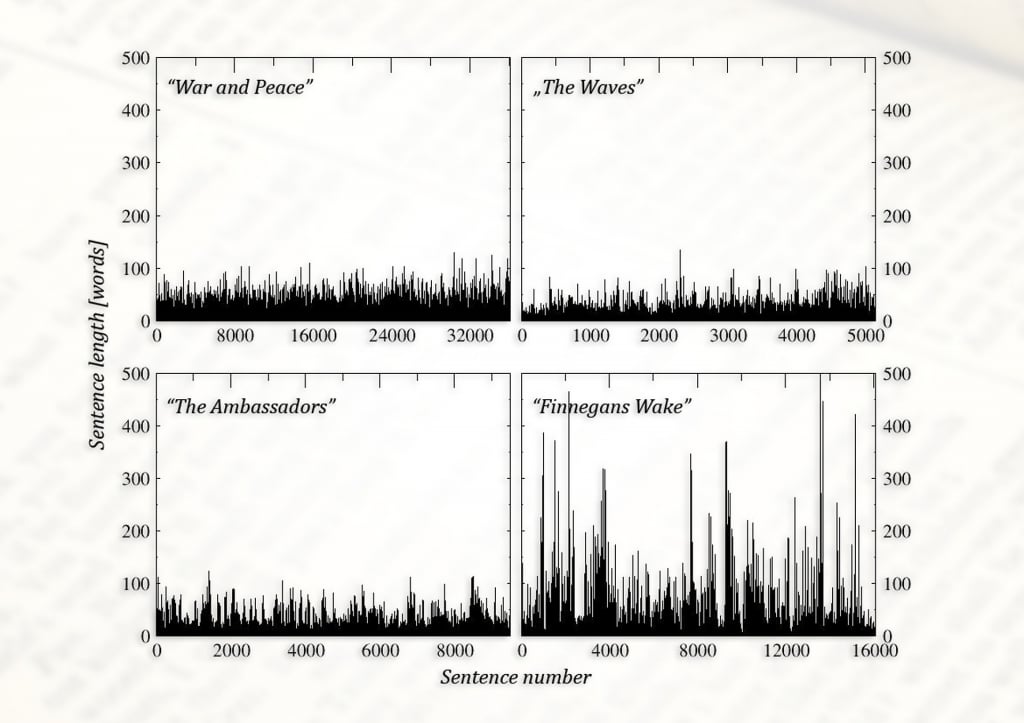Literary Classics Reveal Mathematical Structures
The Nuclear Physics Institute of Poland has found complex fractal patterns in the sentences of some literary works.
It would appear that the world of literature is full of very strict analogies with the world of mathematics. Although at first sight both disciplines might appear opposites, it is logical to think that literary structure, above all when it comes to well-constructed streams of consciousness, draws equations beyond mere linguistic signs, in the abstract and universal world of patterns. Certain great writers have a “formal intuition,” a rhythm that leads them to draw fractals even if they are not aware of it. According to the Nuclear Physics Institute of Poland, James Joyce’s Finnegans Wake, for example, has a structure that is almost indistinguishable from a purely mathematical multifractal.

The academics that set themselves this fascinating task have statistically and meticulously analyzed more than 100 literary works by authors ranging from Charles Dickens to Shakespeare, Alejandro Dumas, Thomas Mann, Umberto Eco, Samuel Beckett and Virginia Woolf. By observing the length of the sentences and how they vary, they found that in an overwhelming majority of texts the correlations in the variations of sentence length were governed by the dynamics of a waterfall, meaning that their construction is a fractal; a mathematical object in which each part, when it expands, has a structure that is similar to everything.
Of course, some texts were mathematically more complex than others, and it is not difficult to guess which. As well as being virtually inaccessible, Finnegans Wake, which won hands down, was followed by Virginia Woolf’s The Waves, Joyce’s Ulysses, Roberto Bolaño’s 2666 and John Dos Passos’ The USA Trilogy. Most interesting of all is that all of the works make much use of the stream of consciousness. Writing about the findings, one of the authors of the study, Dr Paweł Oświęcimka, pointed out:
It is not entirely clear if stream of consciousness writing in fact reveals deeper qualities of our consciousness, or rather the imagination of the writers.

What is certain is that there are writers who are formidable engineers and that the rhythm and intuitive construction of a literary work build castles and rooms in another plane of the world. Joyce, who perhaps sensed much more than he knew he sensed, wrote to Harriet Weaver in a letter about Finnegans Wake, which he was writing at the time:
I am really one of the greatest engineers, if not the greatest, in the world. […] All the engines I know are wrong. Simplicity. I am making an engine with only one wheel. No spokes of course. The wheel is a perfect square. You see what I’m driving at, don’t you? I am awfully solemn about it, mind you, so you must not think it is a silly story about the mouse and the grapes. No, it’s a wheel, I tell the world. And it’s all square.
Here is the triumph of the intuitive form. Perhaps the stream of consciousness of Leopold Bloom in Ulysses is drawing the map that his feet are walking, in the same way that the monologues of the characters in Woolf’s The Waves are making waves in the sea. Intuition is a form of mysticism that believes in universal unity, and these writers codified it in their texts.
Drożdż suggested today that the findings could also be used to posit that writers “uncovered fractals and even multifractals in nature long before scientists. Evidently, they (like Joyce) had a kind of intuition, as it happens to great artists, that such a narrative mode best reflects ‘how nature works’ and they properly encoded this into their texts,” he said. “Nature evolves through cascades and thus arranges fractally, and imprints of this we find in the sentence-length variability.”
Given the already well-established connection between symmetry, truth and beauty (“Beauty is truth, truth beauty”), finding literary works that are fractally quantifiable appears to make perfect sense.
